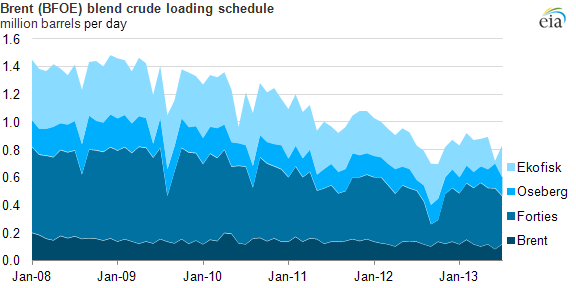
Summer maintenance affects North Sea crude oil production and prices

Note: Click to enlarge.
Republished August 29, 2013, 11:31 am to correct an error in the text.
North Sea Brent is an important global benchmark crude oil that is used to price many different crude oils produced around the world, such as Bonny Light from Nigeria and Sahara Blend from Algeria. Each summer, maintenance on offshore production platforms and pipelines in the North Sea temporarily reduces the supply of North Sea crude oil, which affects the price of the Brent benchmark. The spot prices for four distinct North Sea crudes—Brent, Forties, Oseberg, and Ekofisk—together determine the global benchmark Brent price, and a disruption to any one of these streams affects the overall Brent benchmark price and the price of any crude linked to the benchmark.

Note: The crude loading schedule is a Bloomberg assessment, based on field operators' loading schedules for crude volumes to be loaded on to oil tankers during a given month.
The North Sea Brent crude oil benchmark price is set by evaluating crude prices from four different production fields: Brent, Forties, Oseberg, and Ekofisk (BFOE). Brent, the original crude stream and namesake of the benchmark, began production in 1976. As Brent production declined, additional crude streams were designated part of the benchmark to ensure there were sufficient volumes of physical crude to support Brent liquidity, resulting in the current benchmark. However, as shown in the chart above, overall BFOE volumes have been declining over the past five years.
The Forties stream contributed 45% (405,000 barrels per day [bbl/d] average through July 2013) of the total BFOE loadings. As a result, any maintenance or disruption to the Forties Pipeline System or Buzzard field production reduces Forties cargos available for loading and can lead BFOE prices to rise. Typically, the Forties system goes into maintenance in August for several weeks. Ekofisk is the second largest contributor at 25% (198,000 bbl/d average through July 2013) of BFOE loadings, and it typically undergoes maintenance in June, returning to normal production by late July.

Total BFOE scheduled crude loadings for August 2013 range between 730,000 bbl/d and 790,000 bbl/d. However, recent reports indicate that Forties maintenance is lasting longer than planned, and as a result total BFOE August loadings could be lower than expected. Currently, about 210,000 bbl/d of Forties crude is scheduled to load in August, significantly lower than the 2008-12 August average of 360,000 bbl/d. In addition, 13 Forties cargoes scheduled to load in August have been delayed, with 3 pushed into September. There have also been reported delays in scheduled Ekofisk September loadings, which could cause tightness in the Brent crude oil market to extend into next month.
Since the beginning of 2012, U.S. Atlantic Coast refineries have imported an average 850,000 bbl/d of crude oil, some of which is from the North Sea and Africa, which is indexed to Brent crude prices.
Brent spot crude oil prices have increased in recent days because of concerns about geopolitical unrest.
Tags: Brent, crude oil, liquid fuels, map, oil/petroleum, prices